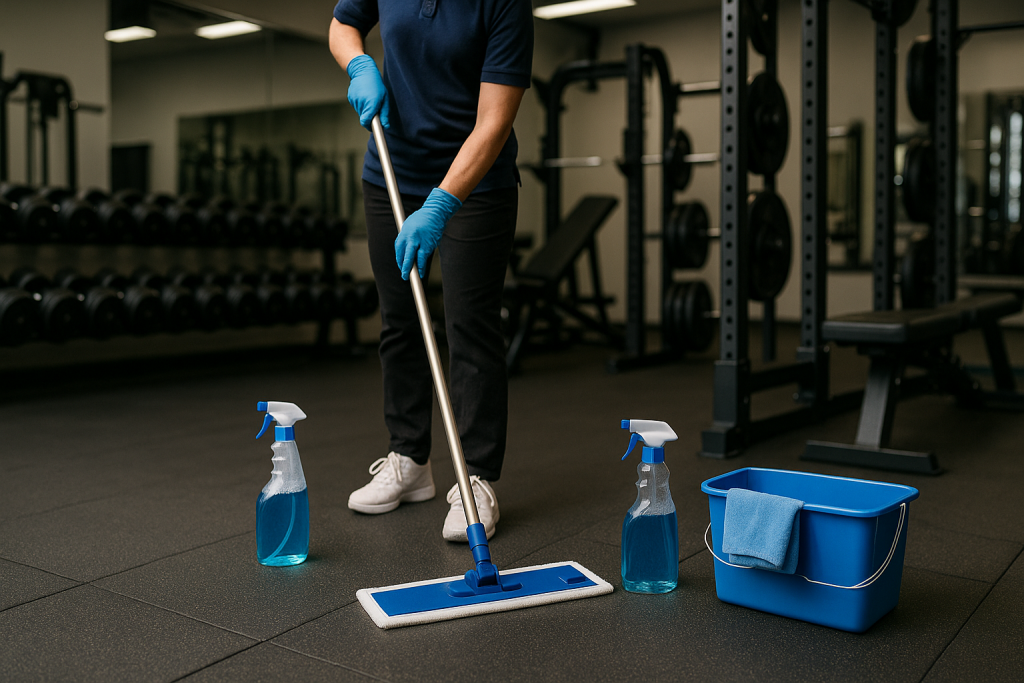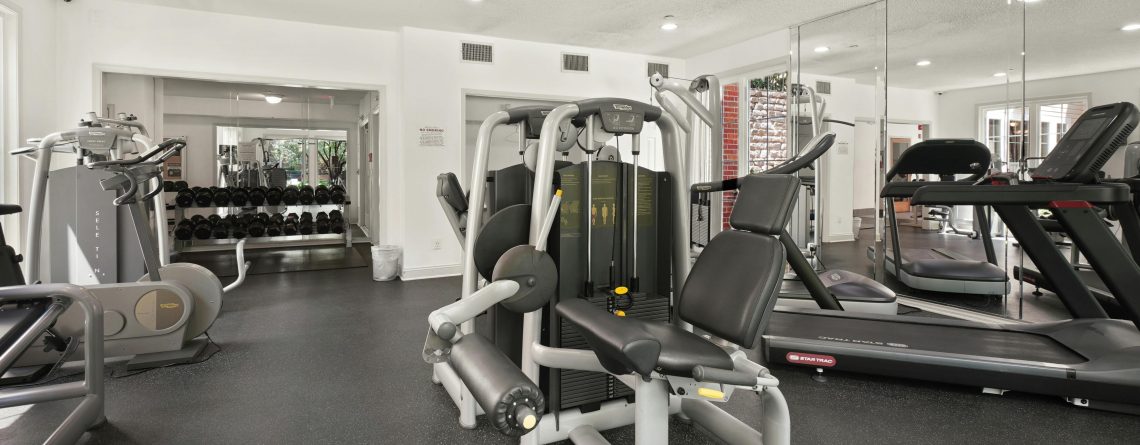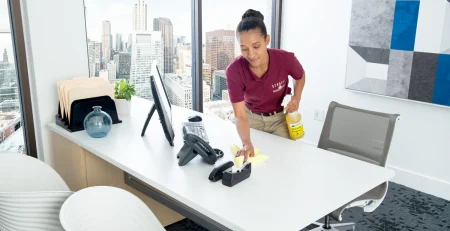A clean gym isn’t just about appearance, it’s essential for the health, safety, and satisfaction of your members. With dozens (or even hundreds) of people using the same equipment daily, gyms can quickly become breeding grounds for germs if not properly maintained. Having a well-structured gym cleaning checklist is essential for ensuring a clean and hygienic environment in your facility.
Whether you manage a large fitness facility or a small personal training studio, having a consistent and thorough cleaning routine helps protect your clients, extend the life of your equipment, and reinforce a professional image. In this blog, we provide a comprehensive gym cleaning checklist that covers everything from daily wipe-downs to deep-cleaning schedules to ensure that your space stays fresh, safe, and welcoming for everyone who walks through your doors.
Fitness Center Cleaning Checklists
Keeping a fitness center clean requires more than just a quick sweep or occasional wipe-down. With high foot traffic, shared equipment, and constant movement, maintaining a hygienic environment demands a structured and consistent approach. That’s why detailed cleaning checklists are essential. In this section, we’ll outline specific cleaning tasks broken down by area and frequency, including daily, weekly, and monthly, so you can ensure every part of your facility stays spotless, sanitized, and safe for your members and staff.
Daily Gym Cleaning Checklist
Daily cleaning is the foundation of gym hygiene. With dozens of people coming in and out throughout the day, germs, sweat, and dirt can quickly accumulate. Staying on top of these tasks not only keeps your fitness center looking professional, it also helps prevent the spread of bacteria and viruses. Here’s a checklist of essential cleaning duties that should be completed every day:
Lobby & Reception Area
- Wipe down counters, desks, and touchpoints (door handles, pens, keyboards)
- Disinfect front desk equipment (phones, card readers, tablets)
- Clean and sanitize entrance door glass
- Empty trash bins and replace liners
- Vacuum or mop floors, especially in high-traffic zones
Workout Areas (Weight Rooms, Cardio Zones)
- Disinfect all equipment: dumbbells, machines, benches, and mats
- Wipe down cardio machines (handles, screens, seats)
- Check for and clean up any spills or debris
- Organize equipment and ensure storage racks are tidy
- Sweep/vacuum and mop floors with disinfectant
Locker Rooms & Restrooms
- Sanitize all touchpoints: faucets, handles, light switches, and lockers
- Clean toilets, sinks, and showers thoroughly with disinfectant
- Refill soap, paper towels, and toilet paper
- Empty trash and sanitary bins
- Mop floors with antibacterial solution
Group Fitness Studios
- Wipe down all shared equipment (yoga mats, weights, resistance bands)
- Clean mirrors and windows
- Vacuum or mop floors between classes
- Check ventilation and air fresheners
Water Stations & Vending Areas
- Clean and disinfect buttons, nozzles, and surrounding surfaces
- Wipe down vending machines and restock as needed
Tip: Post visible signage encouraging members to wipe down equipment after use—but don’t rely on it alone. Staff should follow through with proper cleaning procedures at regular intervals throughout the day.
Weekly Gym Cleaning Checklist
While daily tasks handle surface-level hygiene, weekly cleaning dives a little deeper. These tasks focus on areas that don’t require daily attention but still play a major role in the overall cleanliness, functionality, and presentation of your gym. Staying consistent with weekly cleaning not only improves the member experience—it also helps extend the life of your equipment and facilities.
Lobby & Reception Area
- Dust and wipe down windowsills, baseboards, and ceiling vents
- Deep clean front desk surfaces and seating areas
- Sanitize front windows and door frames inside and out
Workout Areas
- Move and clean under heavy equipment
- Inspect and disinfect rarely used equipment and accessories
- Wipe down walls and sanitize mirrors
- Clean and organize storage spaces (e.g., weight racks, shelving)
- Disinfect resistance bands, foam rollers, and small accessories
- Check for wear and tear or needed maintenance on machines
Locker Rooms & Restrooms
- Deep clean grout and tile in showers and on floors
- Sanitize locker interiors
- Clean walls, partitions, and doors
- Disinfect drains and check for plumbing issues
- Air out and deodorize the space
Group Fitness Studios
- Sanitize mats and props more thoroughly than daily cleanings
- Deep clean floors and studio mirrors
- Wipe down sound systems, remotes, and other tech
- Clean behind and under storage units or risers
General Facility Tasks
- Disinfect staff break rooms or offices
- Clean HVAC vents and replace filters if needed
- Launder any reusable cleaning cloths or towels
- Inspect and clean light fixtures, fans, and air purifiers
Tip: Schedule these weekly tasks during slower hours or on a designated “maintenance day” to minimize disruption to members.
Monthly Gym Cleaning Checklist
Monthly cleaning focuses on deep-cleaning tasks and preventive maintenance that go beyond the day-to-day and weekly routines. These tasks are essential for preserving your gym’s long-term cleanliness, safety, and functionality. Think of this as your “reset button” each month, addressing areas that are often overlooked but play a critical role in overall hygiene and upkeep.
Entire Facility
- Perform a full inspection of cleaning supplies and restock as needed
- Replace or deep-clean all HVAC air filters
- Clean and sanitize ceiling fans, vents, and high-touch walls
- Power wash entrance areas and sidewalks
- Clean behind large fixtures or immovable equipment
Workout Areas
- Deep-clean and lubricate fitness machines as per manufacturer guidelines
- Tighten bolts, inspect cables, and check for wear and tear
- Professionally clean upholstery on benches and machines
- Dust and sanitize any high-reach areas (light fixtures, signage, speakers)
Locker Rooms & Restrooms
- Strip and deep-clean floors with heavy-duty disinfectant
- Deodorize and sanitize drains and plumbing fixtures
- Inspect and replace worn mats, hooks, or soap dispensers
- Clean inside ceiling panels and vents, if accessible
Group Fitness Studios
- Deep clean and disinfect all props and equipment in storage
- Shampoo or steam-clean carpets or studio mats
- Sanitize instructor stations, audio systems, and storage cabinets
Office and Staff Areas
- Disinfect and organize staff break rooms, offices, and storage areas
- Clean behind appliances, furniture, and supply closets
- Audit and dispose of expired cleaning or maintenance products
Tip: Keep a digital or printed log of monthly cleaning tasks to help track progress and ensure accountability. Involving your team in this process helps build a strong culture of cleanliness and pride in the facility.
Quarterly / Seasonal Gym Cleaning Checklist
Every few months, it’s important to go beyond the regular cleaning schedule and focus on deep-cleaning, preventive maintenance, and seasonal updates. Quarterly or seasonal cleaning helps prepare your facility for changes in weather, membership trends, and general wear and tear. These tasks ensure your gym remains in top shape year-round and looking its best.
Facility-Wide
- Conduct a full safety and cleanliness audit
- Deep clean all flooring (including behind and under all equipment)
- Strip and refinish hard floors (if applicable)
- Wash all walls, windows, and blinds
- Inspect lighting and replace any dim or flickering bulbs
- Schedule professional pest control service (especially in seasonal transitions)
Workout Areas
- Recalibrate and test fitness machines for performance and safety
- Replace worn pads, grips, cables, and upholstery as needed
- Rotate or rearrange equipment for even floor wear and fresh layout
- Perform a full inventory of weights, mats, and accessories and replace damaged or missing items
Locker Rooms & Restrooms
- Deep-clean grout and tiles with professional-grade equipment
- Inspect and replace broken or aging fixtures (faucets, shower heads, lockers)
- Perform mold and mildew inspection, especially in humid months
- Clean air vents and deodorize with seasonal air fresheners or purifiers
Group Fitness Studios
- Update or replace worn props, yoga mats, or resistance bands
- Sanitize and inspect audio/visual equipment for wear
- Repaint or touch up walls and mirrors as needed
- Refresh signage or display boards for upcoming seasonal programs
Administrative & Member Services Areas
- Declutter and reorganize storage closets and cleaning supply rooms
- Shred old paperwork and update digital files/logs
- Review and update cleaning protocols and staff responsibilities
- Refresh decor, displays, or marketing material to reflect the season
Tip: Align your quarterly cleaning schedule with seasonal changes (spring refresh, summer prep, fall flu prevention, winter weather readiness) to keep your gym ahead of the curve both in cleanliness and member experience.
Personalizable Elements
No two fitness centers are exactly alike, which means your cleaning checklist shouldn’t be one-size-fits-all. Whether you run a small boutique studio, a large commercial gym, or a specialized facility like a CrossFit box or yoga center, it’s important to adapt your cleaning routine to fit your space, equipment, and clientele. Here are some key elements to personalize within your cleaning checklist:
- Facility Type
- Boutique studios may prioritize mat and floor cleaning, while high-traffic gyms need more attention to locker rooms and machines.
- Specialty gyms (like martial arts or spin studios) may require frequent sanitation of niche equipment like gloves, pads, or stationary bikes.
- Equipment Inventory
- Tailor the checklist to reflect your actual equipment—treadmills, rowing machines, resistance bands, kettlebells, etc.
- Add special cleaning instructions for high-tech machines with touchscreens or sensors.
- Peak Usage Times
- Adjust cleaning frequency around your busiest hours. For example, schedule midday wipe-downs during high-traffic periods.
- Post-lunch or post-work rushes may require more frequent touchpoint sanitation.
- Climate and Seasonality
- If your facility is in a humid area, you may need to include more mold-prevention tasks.
- Winter months may require more frequent floor cleaning due to salt, mud, or snow being tracked inside.
- Member Demographics
- Family-friendly gyms might need extra cleaning in play areas or family restrooms.
- Senior-focused facilities may want to prioritize air quality, handrail sanitation, and fall-risk inspections.
- Staffing & Schedule
- Personalize the checklist based on your available staff and hours of operation.
- Break tasks down by role (e.g., front desk, janitorial, trainers) to increase accountability and clarity.
Tip: Consider using a digital checklist or app to allow for easy customization and task tracking. This makes it easier to update your cleaning plan as your facility grows or as the needs of your members change.
Supply Checklist
To maintain a clean and hygienic gym, having the right supplies on hand is just as important as having a checklist. Stocking up on high-quality cleaning products, tools, and PPE (personal protective equipment) ensures that staff can perform their duties efficiently and helps you avoid disruptions due to missing materials. Here’s a supply checklist every gym should have on hand:
Cleaning & Disinfecting Products
- EPA-registered disinfectant spray or wipes (for equipment and surfaces)
- Antibacterial multi-surface cleaner
- Glass and mirror cleaner
- Floor disinfectant/cleaning solution
- Tile and grout cleaner (for locker rooms/showers)
- Drain cleaner or deodorizer
- Air fresheners or odor neutralizers
Cleaning Tools & Equipment
- Microfiber cloths and disposable cleaning rags
- Mop buckets and mop heads (separate ones for gym floors and restrooms)
- Brooms and dustpans
- Wet/dry vacuum
- Scrub brushes (various sizes for equipment and grout)
- Dusters (including extendable ones for vents and corners)
- Spray bottles (labeled and refillable)
- Squeegees (for mirrors and showers)
Personal Protective Equipment (PPE)
- Disposable gloves (nitrile or latex)
- Face masks (if required by policy or during illness outbreaks)
- Aprons or cleaning uniforms
- Safety goggles (for chemical use)
Facility Essentials
- Paper towels
- Trash bags (multiple sizes)
- Toilet paper and seat covers
- Hand soap and sanitizers
- Disinfectant wipe dispensers
- Air filters (for HVAC system)
- Batteries or replacement parts for hand sanitizer stations, automatic dispensers, etc.
Optional But Useful
- Label maker (for organizing storage and refill bottles)
- Cleaning caddies or carts for mobile convenience
- Wall-mounted checklist boards for accountability
- QR codes or mobile check-in systems for digital task tracking
Tip: Keep a master inventory list and conduct monthly supply audits to ensure you’re always stocked, especially during flu season or high-traffic times.

Cleaning Schedule – By Yourself or Outsource?
One of the most important decisions gym owners face when implementing a cleaning plan is who will handle the cleaning duties, your in-house team or a professional cleaning service. Both options have pros and cons, and the right choice depends on your facility’s size, budget, staff availability, and expectations for cleanliness.
In-House Cleaning: Pros & Cons
✅ Pros:
- More control: You can train staff to your specific standards and adjust the routine as needed.
- Real-time response: Staff are already on-site to handle unexpected messes or spot clean between peak times.
- Cost-effective (in some cases): Especially for smaller facilities, utilizing current staff for cleaning can save on external vendor fees.
❌ Cons:
- Training required: Staff must be trained in proper sanitation procedures, especially when using commercial-grade cleaners.
- Accountability: Without proper oversight, some tasks may be skipped or rushed.
- Limited availability: Your team may be stretched thin during busy hours, leaving little time for thorough cleaning.
Outsourcing Cleaning: Pros & Cons
✅ Pros:
- Expertise: Professional cleaners are trained in sanitation protocols, especially for shared public spaces like gyms.
- Consistency: Scheduled services ensure regular deep cleaning, often after hours when the gym is closed.
- Time-saving: Allows your staff to focus on customer service and daily operations.
❌ Cons:
- Higher cost: Outsourcing can be more expensive, especially for smaller gyms or 24/7 operations.
- Less flexibility: Cleaning services may only be available at set times, limiting last-minute cleaning needs.
- Quality varies: The level of service can vary between companies so vet providers carefully and monitor their work regularly.
What’s the Right Fit for Your Gym?
Consider a hybrid approach using in-house staff for daily wipe-downs and real-time cleaning, and outsource weekly or monthly deep cleans to commercial cleaning professionals. This ensures your facility is consistently clean while maintaining flexibility and cost control.
Tip: No matter which option you choose, always maintain a cleaning log or checklist to ensure accountability and transparency.
Your Resources vs. Cleaning Staff
When building an effective gym cleaning routine, it’s important to distinguish between what you, as a facility owner or manager, are responsible for providing and what your cleaning staff are responsible for executing. Clear boundaries help prevent confusion, streamline operations, and ensure everyone is equipped to maintain a safe and hygienic environment.
Your Responsibilities (Management/Ownership):
- Provide Supplies & Equipment: Ensure cleaning staff have everything they need including disinfectants, mops, gloves, trash bags, etc. Keep an inventory and restock regularly.
- Set Cleaning Standards: Define clear expectations, routines, and frequency for every task, daily, weekly, monthly, and seasonal.
- Train or Onboard Staff: Whether using internal employees or an external vendor, everyone needs to understand your specific facility needs and safety protocols.
- Create and Post Checklists: Visible checklists and cleaning logs help staff stay accountable and on schedule.
- Schedule Appropriately: Ensure cleaning times align with facility hours and member flow (e.g., extra staff during peak hours or post-class cleanup).
- Inspect & Monitor: Regularly audit cleaning performance, provide feedback, and adjust responsibilities as needed.
Cleaning Staff Responsibilities:
- Follow Assigned Checklists: Complete tasks according to the schedule and cleaning standards provided.
- Use Supplies Properly: Apply the right products for each surface and follow safety guidelines (e.g., dwell times for disinfectants).
- Document Tasks: Fill out cleaning logs or reports to show completed work and flag any issues.
- Report Problems: Alert management to supply shortages, broken equipment, or facility maintenance needs.
- Maintain Professionalism: Cleaning staff should represent the gym’s brand by being courteous, thorough, and detail oriented.
Tip: Treat your cleaning team like essential partners, not just behind-the-scenes workers. When they feel valued and supported, the quality of their work improves, and your gym reflects that.
Your Disinfectant Spray vs. Professional Solutions
Not all cleaning products are created equal. While off-the-shelf disinfectant sprays may be convenient and budget-friendly, they often fall short in high-traffic environments like gyms. Choosing the right products and understanding the difference between consumer-grade and professional-grade solutions can make a big impact on hygiene, safety, and member trust.
Consumer-Grade Disinfectant Sprays (e.g., store-bought brands):
✅ Pros:
- Easy to find and affordable
- Great for spot cleaning or touch-ups
- Can be used by staff or even members for quick wipe-downs
❌ Cons:
- May not be EPA-registered for use in fitness or medical facilities
- Often have limited dwell time (time needed to kill bacteria/viruses)
- Can leave sticky residues or strong odors
- Not always effective against resistant pathogens like MRSA or norovirus
Professional-Grade Cleaning Solutions:
✅ Pros:
- Designed specifically for commercial environments
- More effective against a broader range of pathogens
- Often have faster kill times and longer-lasting protection
- Can be used with electrostatic sprayers or foggers for large areas
- Better suited for high-contact surfaces like gym equipment, mats, and locker rooms
❌ Cons:
- Typically more expensive
- May require training to use safely and correctly
- Often need to be ordered through janitorial supply vendors or service contracts
Finding the Right Balance
For most fitness facilities, the best approach is a combination of both:
- Use consumer-grade sprays or wipes for daily touchpoints and member use
- Reserve professional solutions for staff-led cleaning routines and deep cleaning sessions
Always check the EPA registration number and make sure your disinfectant is approved for use in gyms or public spaces. And don’t forget to follow proper dwell times, spraying and immediately wiping won’t always get the job done.
Tip: Post signage reminding members to use provided sprays or wipes before and after using equipment but don’t rely on that alone. Professional cleaning should always back up your safety measures.
How to Effectively Manage Your Cleaning Routine
Creating a cleaning checklist is only the first step, managing the routine is what ensures it actually gets done consistently and correctly. An effective cleaning program requires structure, oversight, and flexibility. Whether your team is in-house or outsourced, the key to success is making the process visible, trackable, and repeatable.
- Assign Clear Roles
- Define who is responsible for each task: front desk staff, janitorial team, trainers, or third-party cleaners.
- Use job descriptions and training to clarify cleaning responsibilities for each role.
- Use Checklists (and Make Them Visible)
- Post printed checklists in cleaning supply areas, staff rooms, or behind the front desk.
- Break them down by frequency: daily, weekly, monthly, and seasonal tasks.
- Consider digital task-tracking tools for real-time updates and accountability.
- Create a Cleaning Schedule
- Align cleaning times with your facility’s traffic flow (e.g., during slow periods or post-class).
- Include scheduled deep cleaning on a calendar to avoid it getting overlooked.
- Ensure overnight or early morning cleaning doesn’t clash with maintenance or special events.
- Monitor and Inspect Regularly
- Perform routine walk-throughs to ensure standards are being met.
- Use inspection forms or staff check-ins to catch missed tasks or recurring issues.
- Encourage team leads or managers to verify completion and quality of work.
- Keep Communication Open
- Allow cleaning staff to report issues (e.g., supply shortages, equipment problems).
- Host short weekly check-ins to address challenges or make routine adjustments.
- Recognize staff who consistently meet or exceed expectations.
- Stay Flexible and Adaptable
- Update cleaning routines based on seasons, member feedback, or unexpected health concerns.
- Have a backup plan when someone is absent or during high-traffic events.
Tip: Cleanliness is part of your brand. When your gym looks, feels, and smells clean, it builds trust and members are more likely to stick around and refer others.
Professional Gym Cleaning Services from Stratus
A clean gym isn’t just a luxury, it’s a reflection of your brand, your commitment to member safety, and the foundation for a positive workout experience. By implementing a structured cleaning routine with clearly defined checklists, supplies, and responsibilities, you can maintain a facility that feels fresh, safe, and welcoming every single day.
Whether you choose to handle cleaning in-house, outsource it, or take a hybrid approach, consistency is key. From daily disinfecting to seasonal deep cleans, every effort counts toward creating a space that members trust and enjoy returning to.
If you’re looking to enhance your facility’s cleanliness or want peace of mind knowing every surface is expertly sanitized, partnering with a professional cleaning provider may be the perfect solution. Stratus Building Solutions provides fitness center cleaning in Palm Beach County and the broader Treasure Coast.
🔹 Why Choose Stratus for Gym or Fitness Center Cleaning?
- Custom Cleaning Plans: Stratus works with you to assess your facility and develop a checklist-aligned cleaning schedule, including restrooms, locker rooms, equipment rooms, workout spaces, water stations, and more.
- Green Cleaning Expertise: Our in-house Green Clean program uses Green Seal-certified, biodegradable, non-toxic, low-VOC cleaning products, HEPA filtration vacuums, and microfiber tools to reduce indoor air pollution and promote safety in high-touch fitness environments.
- Advanced Disinfection Tools: From hospital-grade disinfectants to UV-C sanitation wands and electrostatic sprayers, we use cutting-edge methods perfect for eliminating germs and pathogens from high-contact surfaces.
- Flexible Service Options: Choose a one-time deep clean or opt into a recurring janitorial program tailored to your facility’s needs and schedule, including day porter services, floor care, carpet cleaning, or post-construction cleanup.
Investing in a professional cleaning partner not only ensures hygiene and member safety but also improves the impression of your brand’s quality and care. If you’re in Palm Beach County, Martin County, St. Lucie County, or Indian River County, FL, reach out to Stratus Building Solutions at 561‑469‑8795 for professional gym cleaning services.
Frequently Asked Questions
It’s not just about looking good a clean gym protects your members from germs, keeps your equipment in top shape and creates a safe and comfortable space.
High traffic areas like equipment, locker rooms and reception areas should be cleaned daily. Weekly and monthly deep cleans handle grout, vents and behind equipment. Seasonal cleaning helps with long term maintenance and weather related messes.
Daily cleaning should include wiping down all equipment, sanitizing restrooms and locker rooms, vacuuming or mopping floors, disinfecting touchpoints and tidying high use areas like the lobby and water stations.
Weekly cleaning goes deeper—like scrubbing tiles, cleaning under machines and sanitizing mirrors and props. Monthly cleaning tackles tasks like power washing entrances, deep cleaning HVAC vents and inspecting equipment for wear and tear.
Disinfectant sprays, microfiber cloths, mops, vacuums and PPE like gloves. For deeper cleans HEPA vacuums, steam cleaners and floor buffers come in handy.
Both have benefits. In-house staff can respond quickly and know your space well, while outsourcing ensures consistent professional results. Many gyms use a hybrid model: daily basics in-house, deeper cleans outsourced.
Use printed or digital checklists, assign clear responsibilities and do regular walk-throughs or inspections. Visibility, accountability and good communication are key.
Use non-abrasive, EPA approved disinfectants and let them sit for the recommended dwell time. Don’t spray directly on screens or electronic parts—apply to a cloth first.
Behind large machines, under mats, inside vents and high touch areas like remotes or sound systems in group studios. Seasonal and monthly cleaning should cover these.
Green certified products, electrostatic sprayers and custom plans for your gym’s layout and traffic.










